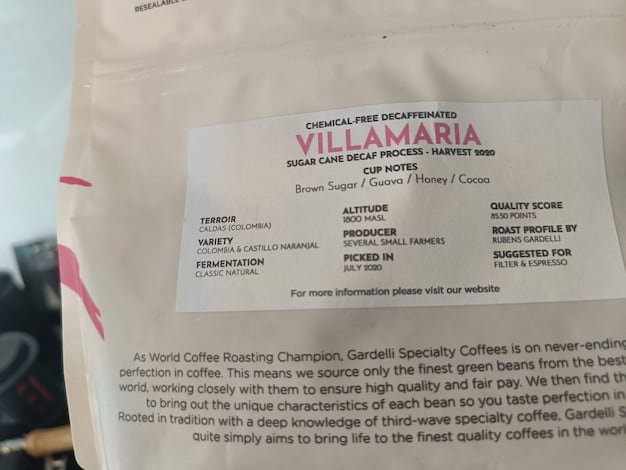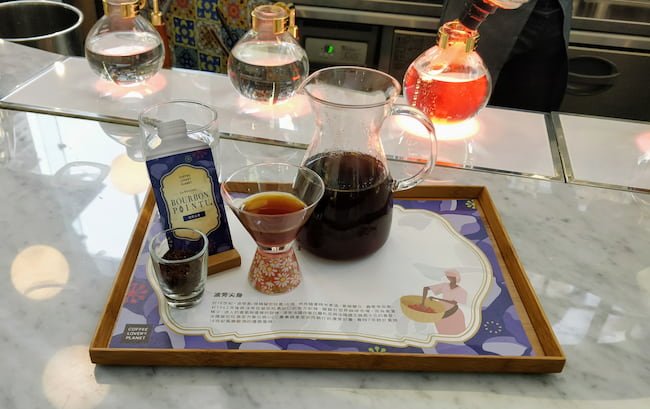One of the main reasons that we all love coffee so much is caffeine.
However, as hardcore coffee lovers, sometimes we want to drink coffee for the flavor; we don’t necessarily want the side effects.
In the past, there was only one answer to that dilemma: Decaf coffee 🤷♂️
However, today things are a bit more complex.
We have a new category of beans available, intuitively knowns as “low caffeine coffee” or just “locaf”
While there are huge differences among these bean types, they all share one commonality: Being naturally low in caffeine.
In this article, I’ll tell you everything you need to know about this type of coffee.
Caffeine Explained
Caffeine is a stimulant found naturally in coffee beans. Caffeine helps increase alertness and energy levels. It’s the reason drinking coffee feels like getting superpowers in the morning.
However, we don’t often look at caffeine from the plant’s point of view.
But here’s a quick recap: Coffee doesn’t produce caffeine to make humans more energetic. No, it’s the plant’s natural defense against pests and insects.
As such, it’s easy to understand why different coffee species might have different caffeine levels.
💡 For instance: Robusta usually has almost double the amount of caffeine compared to Arabica! The effects of drinking pure robusta can be quite mind-bending.
On the contrary, there are also low caffeine species. For example, Liberica could be described as such since it only contains about 75% of the caffeine levels of Arabica. However, this is insufficient to be a viable alternative to decaf coffee, so I won’t spend more time discussing it in this article.
How much caffeine?
The main reason humans have so much affection for coffee is probably due to caffeine.
But if the love affair was only about the caffeine, wouldn’t we all just be drinking cheap Robusta?
Since this is hardly the case, there must also be a different component, which is more about coffee’s flavor. And perhaps even the whole ritual around consuming it?
But can you get too much caffeine? The answer depends on how much you consume. If you drink less than 200 mg of caffeine daily (about two cups of regular coffee), you probably won’t experience any adverse side effects.
However, if you drink more than 400 mg of caffeine daily, you risk experiencing some adverse reactions. This includes headaches, anxiety, insomnia, nervousness, irritability, tremors, palpitations, rapid heartbeat, and even seizures.
And then there’s also the question about what time of the day you consume it.
After six hours, half of the caffeine has been eliminated from your blood stream. But caffeine takes at least 10 hours to be out of your system entirely.
For most people, the main issue with caffeine is its potential adverse side effects on sleep.
Low caffeine coffee
But here’s the good news. Thanks to several unique types of coffee varieties and species, you don’t have to miss out on the real taste of coffee, even though you’re on a caffeine restriction plan.
Low caffeine coffee refers to coffee that hasn’t been subjected to decaffeination. This coffee is less caffeinated than regular coffee but still wholly “normal,” so to speak.
Previously, there was not much demand for this type of coffee, but with increasing interest in health and lifestyle, coffee producers are finding plants that can meet this demand.
Even though Arabica and Robusta coffee thoroughly dominate the global trade, there are many wild coffee species with untapped attributes regarding flavor and raw biological potential.

Aramosa Coffee
Aramosa is one type of low-caffeine coffee. It’s a crossbreed between two different species of coffee.
The first one we are all familiar with: Coffea Arabica. The second is Coffea Racemosa, a tiny lesser-known species growing wild in South Africa and Zimbabwe. It actually had a brief period as a commercial crop in Mozambique in the 1960s and 1970s, but it never became a big success among farmers to its modest yield.
Aramosa is a hybrid variety of the two and shares traits with both parents.
It produces coffees with mild flavors and low amounts of caffeine.
Because of this crossbreeding, Aramosa has a unique flavor profile while offering only half the caffeine content of Arabica coffee.
It’s often described as having a sweet aroma with hints of florals and chocolate. This means that Aramosa is perfect for those who want a milder alternative to regular coffee without compromising on the taste.
Personally, I have enjoyed this type of bean as pour over and espresso. It has low levels of bitterness, making it a smooth and exciting experience.
Laurina Coffee
Laurina coffee comes from the island of Réunion in the Indian Ocean. It’s an arabica hybrid evolving naturally from Bourbon. It’s also sometimes called Bourbon Pointu due to its pointy shape.
Laurina coffee is an arabica varietal that naturally contains less caffeine. It only has around 25-50% of the caffeine content of regular arabica coffee beans.
This means you can drink much more Laurina coffee without feeling jittery or having problems sleeping.

Laurina is very sweet, and its flavor profile is reminiscent of fruit flavors and delicate florals. It’s very aromatic and low in bitterness (caffeine is one of the most bitter compounds in coffee, so being low caffeine usually implies low bitterness.)
Because of its unique taste, Laurina is popular among coffee connoisseurs. However, it’s also becoming increasingly popular among consumers who prefer low caffeine alternatives.
As a result, Laurina is a sought-after coffee that fetches very high prices at the moment. However, one can hope that more farmers will start cultivating this crop so the prices can be pushed down further.
Join me in this video and get a feel for how coffee is grown at the farm 👇
What about Eugenioides Coffee?
Eugenioides Coffee is a form of coffee that’s indigenous to East Africa. It’s one of the parents of the Arabica species that we all cherish and love.
However, Eugenioides is challenging to cultivate, so it hasn’t been of much commercial interest until recently when it came into the limelight during the World Barista Championship and Brewers Cup in 2021.
Due to the scarcity, it’s costly and hard to get your hands on. However, it does have an intensely sweet and unique flavor profile, according to the limited number of people who have tried it.
It’s also low in caffeine, only about half of normal Arabica. However, it doesn’t seem likely that Eugenioides will fill a void in the “locaf” coffee market since it’s so rare and difficult to grow. I predict that it will first and foremost be something that connoisseurs and super-geeks consume for the flavor and the novelty.
Decaffeination
Decaf coffee is a controversial topic. Besides feeling like a betrayal against the nature of coffee, many people claim that the decaffeination process makes the coffee taste worse than regular coffee. Hence, the interest in better tasting natural “locaf” varieties.
There are several different methods used to decaffeinate coffee; however, I’m only really impressed by one of them: The “sugar cane method.” This is a relatively new method that seems to be on the rise in terms of popularity.
These coffee beans have a unique flavor — one that I would describe as being quite pleasant if you’re into natural processed, fermented coffees.
The sugar cane method uses a natural product called ethyl acetate, which is derived from molasses. Because ethyl acetate is naturally found in sugar cane and other crops, the process is labeled “naturally decaffeinated.”

Historical methods
The first decaf method involves soaking or steaming the coffee beans in hot water. This type of decaffeination has been known since 1903.
Back in the day, various unhealthy chemicals were also added to make the process more efficient. This helps to remove the caffeine but also impacts the flavor. Today, this method uses milder food-safe solvents.
Another method that has actually become quite popular in specialty coffee circles is the so-called “Swiss water process.” This method relies on “Green Coffee Extract.” In this process, the beans release caffeine via osmosis. The beans are soaked in the extract, and they will release caffeine due to the laws of equilibrium. You could call it a natural method but a very complex one.
Conclusion
Coffee is a delicious beverage with lots of health benefits. If you want to enjoy your favorite cup of joe while avoiding the side effects of caffeine, then Laurina or Aramosa might be for you.
If you’re looking for something that tastes great but doesn’t contain caffeine, I urge you to check out some decaf made via the sugar cane process.
The two coffee types, Laurina and Aramosa, are probably the best options if you want to limit caffeine intake. These varietals contain less caffeine while still tasting like specialty coffee.
Yes, it’s still pretty rare in the shops, but it’s becoming increasingly popular. In recent years, artisan roasters and specialty coffee shops have started offering more coffee naturally low in caffeine.
It’s very difficult to remove all caffeine completely, but many products will be so low in caffeine that you won’t experience any effects. For example, most decaf coffee should have less caffeine than tea, soft drinks, or hot chocolate. Research indicates that 14-20 cups of decaf are the equivalent of one regular cup caffeine-wise.
